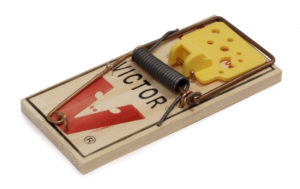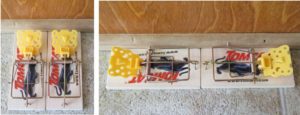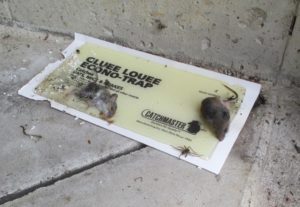Monitoring – Rodent Trap Selection
General Considerations
There are many types of rodent traps to choose from. Selecting the best type of trap for your application is important to the success of your monitoring program. Use of an inappropriate trap style can mean fewer captures, lower efficiency in servicing traps, secondary infestation of rodent carcasses by insects, or an animal’s unnecessary pain and suffering. As a result, it may also impact the quality of your monitoring data. For example, rodents may avoid traps that are not positioned properly, or placed outside of natural runways. On the other hand, using remote traps in locations that are difficult to access may reduce servicing time by allowing pest management professionals to focus on known captures and allow them to more efficiently record, clear, and reset traps.
No trap is perfect for all monitoring applications. It is important to match the trap to the needs of a particular situation. Some considerations include:
- Presence of known or suspected runways
- Proximity to human disturbances (will the trap get bumped or kicked?)
- Visibility concerns
- Ease of access to the trap location for servicing
- Outdoor vs. indoor use
- The size or capacity of the trap
Key Resources:
- Rodent Trapping Tip Sheet, Museum Pests Working Group
- Vertebrates, Museum Pests Working Group
Snap Traps
Snap traps are the preferred method of trapping mice.
- Snap Traps should be placed perpendicular to the wall with the trigger against the wall or parallel to the wall, preferably with two traps back to back with the triggers facing outward (see double trapping for more information).
- Expanded trigger traps are snap traps with a larger trigger area and are the preferred type of snap traps. They will give you 17% more catches.
- Reuse traps if possible, but use gloves.
- Place traps in quiet corners in order to catch them when they are slowing down a bit rather than in the middle of their run or along walls.
- Gluing snap traps on a board can be helpful for placement and removal once the trap is sprung
Traps should be baited using non-lethal attractants. Options include:
- Whatever mice are already feeding on
- Cotton balls (females will instinctively seek out cotton for nesting)
- Nutella
- Tootsie-roll pieces
*Avoid baiting with peanut butter, as it poses allergy concerns in public spaces and is so effective that it can attract more rodents.
Double Snap Traps
The so-called “popcorn response,” triggered when mice sense an issue with the first trap, will cause them to jump to get out of the way of the first trap, falling into the second trap. These tactics work best with snap-traps and expanded trigger traps.
Three options for “double trapping” include:
- Set up a first trap abutting a second trap, with both traps parallel to the wall and with triggers to the outside/away from one another.
- Set up one trap on either side of a corner, each perpendicular to their own wall with triggers towards the wall.
- Set up two traps, both perpendicular to the wall and right next to each other, (double wide-style) with triggers towards the wall.
Key Resource: Mouse Snap Trap Placement Diagram, Museum Pests Working Group
Glue Traps
Flat glue traps are sometimes used to trap rodents. These traps have a thicker glue layer (2 – 4 mm) than those needed to trap insects. Generally other methods such as snap traps or live traps are considered to be more humane for rodents because they are less likely to cause prolonged suffering.
If you are considering using these traps, please check your local regulations to ensure that they are permitted. These are currently banned in the UK.
- While snap traps are preferred, occasionally glue traps are also necessary.
- Larger, rat-sized boards with a thicker glue layer are best.
- Freeze boards first to ease removal of contact paper/release paper.
- Low-temp glue boards exist for use in cold (eg: in refrigerators and freezers).
- Flat glue boards are better than trays/mice will run around or bypass trays.
- Can be used in combination: glue boards alone will get about 70%. You’ll need a combo to get both. Traps and glue boards on a perimeter, traps in the corners, boards along the runs. You can wrap a glue board around pipes – more for rats than mice, because mice eventually come down to eat.
- If glue boards are not allowed in your institution during public hours, place them at closing and retrieve them in the morning before opening.
- Trap position: place along runs or in areas with smudges (grease markings).
- Dead mice will also attract insects; traps should be checked regularly and only used strategically as necessary.
Multi-Catch Traps
While “No Kill” traps may initially appear on the surface to be a more humane option, they can often result in a prolonged, painful death when compared to a quick-kill snap trap solution. Most trapping/monitoring IPM campaigns will not have the resources to be able to check traps in frequent enough intervals. This may require contracted help.
- Rodents can die within 6-12 hrs of being trapped.
- Multi-catch traps can result in stress, fighting, and even cannibalization for the trapped animals.
- Dead mice will also attract insects; traps therefore should be checked regularly and only used strategically as necessary.
Bait Stations
NEVER USE RODENT BAIT inside museums, historic houses, libraries, or archives!
- Poisoned rodents often die in hidden voids (behind walls, under floorboards, etc.) leaving carcasses that are difficult to find/remove.
- Hidden carcasses attract flies, hide beetles, carpet beetles, clothes moths, and other pests that will attack collections when the carcass is finished.
- Many commercial rodent baits come unintentionally pre-tainted with dermestid eggs, which will soon hatch and attack collection.
- Do not use bait near buildings if mice may enter afterwards. Performing proper exclusion (sealing up the building envelope) first can reduce the chance of void odors.
Exterior baiting must be managed in consultation with a PMP (Pest Management Professional). Monitor/work with your PMP to ensure:
- Correct baits/traps are used and they are well-located
- Check local ordinances regarding allowable uses of rodenticide baits.
- Do NOT use anticoagulant baits where they may cause secondary poisoning in predators who may ingest dead rodents.
- Use products without secondary toxicity to raptors, coyotes and other animals, such as baits using vitamin D3 as the active ingredient.
- That the PMP regularly maintains the baits/traps
- Check outdoor traps quarterly, if not monthly.
- Snap traps or glue boards can be included in bait station units if well-monitored.
- That the PMP monitors baits/traps meaningfully
- That technicians actually unlock, open, and check each box
Remote Rodent Monitoring Technology
Overview
Beginning in 2016, remote rodent monitoring technology (RRMT) emerged to substantially assist in providing early detection of common and ubiquitous rodent pests that invade museums and other sensitive operations and businesses. New sensor technologies continue to appear on the market, originating from some of the largest scientific corporations as well as smaller entrepreneurs.
RRMT uses sensors (detecting movement, touch, or trap activation) to provide continuous monitoring of rodent traps and runways. It relies on a combination of hardware and ongoing services that typically include the following:
- Subscription or service contracts
- Hardware ownership or rental
- Specialized traps with integrated sensors
- Sensors that are compatible with traditional off-the-shelf bait stations, snap traps, and/or multi-catch traps
Benefits
Users are notified of activity or captures by email or text via WiFi, cellular data, or Bluetooth. Key benefits over traditional trapping are:
- Equips pest management professionals to service traps promptly after capture, reducing the likelihood that dead rodents lie out long enough attract and support secondary pests (e.g.,. moths and beetles).
- Makes it possible to more easily monitor difficult-to-access areas (e.g., ceilings, wall voids, and basements) where traditional trapping is dificult or impossible.
- Reduces time spent checking empty traps to improve overall pest management efficiency and free up time for preventive activities (e.g., exclusion).
Testing
Between 2017 and 2019, the American Museum of Natural History (AMNH) in New York City trialed several RRMT systems against the challenges of a large, structurally complex, functionally diverse institution. Results of this study are available in the Proceedings from the 4th International Conference on Integrated Pest Management, IPM 2019, Integrated Pest Management for Cultural Heritage, held in Stockholm 21–23 May 2019. The trial identified several characteristics of greatest importance for assessing these systems, including:
- Compatibility of wireless networks that support sensor communication
- Ease of system installation and maintenance
- Adaptability of sensors to various environments and use cases
- Data management and visualization
Key Considerations in Selecting a Remote Rodent Monitoring System
What type of rodent(s) are you targeting? Choose monitors for rats, mice, or both.
What kind of wireless network coverage is available in your trapping areas? If existing WiFi or cellular signal strength is good, standalone monitors are simple to set up. Hub systems provide consistent coverage where it is needed but require more time to install.
How many monitors do you need? The effort of installing a hub system may not be justified if only a few monitors are needed.
What type of traps and enclosures are suitable for your facility, and where are they used? Systems vary widely in their compatibility. Realizing the benefits of greater versatility requires greater engagement with the system on the part of the pest control operator.
How important are mapping tools to keeping track of your trap inventory, and for communicating trap locations to affiliated pest professionals? Mapping to digitized floorplans is important for discriminating trap locations in large multi-level facilities. Location hierarchies used by different RRMT platforms may suit some approaches to data organization better than others.





